|
|
|
Sort Order |
|
|
|
Items / Page
|
|
|
|
|
|
|
| Srl | Item |
| 1 |
ID:
111783


|
|
|
| 2 |
ID:
106882
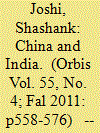

|
|
|
|
|
| Publication |
2011.
|
| Summary/Abstract |
This article surveys the key loci of Sino-Indian tension, situating them within the context of a classical if uneven security dilemma. It then examines the sources of stability within the relationship, arguing that the scope and intensity of conflict is attenuated by a series of military, political, economic and other factors. Lastly, the essay discusses the implications of the analysis for external powers, and the possible trajectories of the relationship.
|
|
|
|
|
|
|
|
|
|
|
|
|
|
|
|
| 3 |
ID:
139519
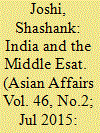

|
|
|
|
|
| Summary/Abstract |
This article traces the outlines of India's engagement with the Middle East, focusing on security-related aspects of that engagement. First, it argues that India's approach towards the Middle East has undergone less transformation than that seen in Indian policy towards other key regions, notably the United States and Asia. Second, it describes how India has responded to recent, and older, episodes of political disorder in the region, and what patterns might be identified from these. Third, it traces aspects of India's relationships with Iran and Saudi Arabia, an exercise that brings some of those patterns into sharper relief. Fourth, and finally, the paper concludes by asking how India might orient itself in the region in the future.
|
|
|
|
|
|
|
|
|
|
|
|
|
|
|
|
| 4 |
ID:
143183
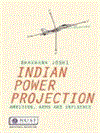

|
|
|
|
|
| Publication |
Philadelphia, RUSI, 2015.
|
| Description |
xi, 142p.: tables, figurespbk
|
| Series |
Whitehall Papers Series; 85
|
| Standard Number |
9781138654969
|
|
|
|
|
|
|
|
|
|
|
|
Copies: C:1/I:0,R:0,Q:0
Circulation
| Accession# | Call# | Current Location | Status | Policy | Location |
| 058456 | 355.033554/JOS 058456 | Main | On Shelf | General | |
|
|
|
|
| 5 |
ID:
094059


|
|
|
|
|
| Publication |
2010.
|
| Summary/Abstract |
Since 2001, India has become Afghanistan's fifth-largest donor, pledging $1.2 billion in funds. Is this merely an attempt to increase leverage over Pakistan, or could India become part of the regional solution on which Western powers have increasingly pinned their hopes? Shashank Joshi analyses the motivations behind India's own Af-Pak strategy.
|
|
|
|
|
|
|
|
|
|
|
|
|
|
|
|
| 6 |
ID:
122927
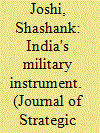

|
|
|
|
|
| Publication |
2013.
|
| Summary/Abstract |
For six years, India has sought to implement an army doctrine for limited war, 'Cold Start', intended to enable a Cold War era force optimised for massive offensives to operate under the nuclear threshold. This article asks whether that is presently feasible, and answers in the negative. Doctrinal change has floundered on five sets of obstacles, many of which are politically rooted and deep-seated, thereby leaving the Army unprepared to respond to challenges in the manner envisioned by the doctrine's architects.
|
|
|
|
|
|
|
|
|
|
|
|
|
|
|
|
| 7 |
ID:
133162
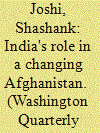

|
|
|
|
|
| Publication |
2014.
|
| Summary/Abstract |
As 2014 draws to a close, the war in Afghanistan will reprise the peripheral role it occupied for the United States and NATO between 2001 and 2006: out of sight, out of mind, and a distraction from other more pressing strategic challenges. Al-Qaeda's center of gravity has shifted away from Pakistan, at most a few hundred al-Qaeda operatives are left in Afghanistan, and the United States and European publics are weary of war.
For India, however, the Western drawdown of forces, culminating in the withdrawal of all US troops by 2016, will represent the greatest adverse structural shift in its security environment for over a decade, with potentially far-reaching implications for the Indian homeland and the country's regional position. It is a mistake to think that New Delhi would be inclined or able to salvage a disappointing military campaign on behalf of the West. The risk exists that India, like other regional actors anxious over the prospect of a security vacuum in the coming years, may adopt more independent and assertive policies in Afghanistan which diverge from those of the United States. However, one would be equally remiss to overlook the fundamental congruity of interests between Washington and New Delhi, and the opportunities that this might afford for cooperation.
|
|
|
|
|
|
|
|
|
|
|
|
|
|
|
|
| 8 |
ID:
129781
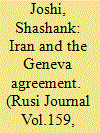

|
|
|
|
|
| Publication |
2014.
|
| Summary/Abstract |
The November 2013 agreement between Iran, the EU and six of the world's major powers is just the first of the diplomatic breakthroughs that will be needed to solve the longstanding nuclear dispute between the two sides. Indeed, the most challenging diplomacy - to move from an interim to a comprehensive and then to a 'final' deal - still lies ahead. Shashank Joshi analyses the terms of the Geneva Agreement before exploring the necessary conditions and likely stumbling blocks affecting any such future agreements at both the national and international levels.
|
|
|
|
|
|
|
|
|
|
|
|
|
|
|
|
| 9 |
ID:
122230
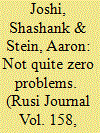

|
|
|
|
|
| Publication |
2013.
|
| Summary/Abstract |
The ongoing civil conflict in Syria - a significant external security threat for neighbouring Turkey - has found Ankara unable to formulate a fully successful response. Shashank Joshi and Aaron Stein argue that the recent deployment of NATO's Patriot missile-defence system is a compromise solution that indicates how dependent Turkish defence and security policy still is on its Western allies.
|
|
|
|
|
|
|
|
|
|
|
|
|
|
|
|
| 10 |
ID:
124870


|
|
|
|
|
| Publication |
2013.
|
| Summary/Abstract |
Tactical nuclear weapons have become increasingly central to Pakistan's nuclear thinking in the past three years, significantly raising the risks of nuclear warfighting and accidents in periods of crisis, without producing military benefits.
|
|
|
|
|
|
|
|
|
|
|
|
|
|
|
|
| 11 |
ID:
118519
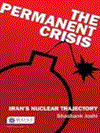

|
|
|
|
|
| Publication |
Abingdon, RUSI, 20121.
|
| Description |
vii,133p.pbk
|
| Series |
Whitehall Papers Series
|
| Standard Number |
9780415832564
|
|
|
|
|
|
|
|
|
|
|
|
Copies: C:1/I:0,R:0,Q:0
Circulation
| Accession# | Call# | Current Location | Status | Policy | Location |
| 057110 | 623.451190955/JOS 057110 | Main | On Shelf | General | |
|
|
|
|
| 12 |
ID:
104765
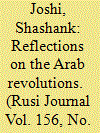

|
|
|
|
|
| Publication |
2011.
|
| Summary/Abstract |
We are witnessing a series of revolutions and uprisings of a pace, connectivity and breadth for which the only parallel in modern history is 1989. But these aspirant and actual revolutions are incomplete, uneven and unpredictable. Shashank Joshi argues that long-held assumptions about the Western trilemma in the Middle East - the choice between democracy, stability and pro-Western foreign policy - must now be urgently re-evaluated.
|
|
|
|
|
|
|
|
|
|
|
|
|
|
|
|
| 13 |
ID:
145409


|
|
|
|
|
| Summary/Abstract |
This paper examines India’s strategic environment in the round. ‘Strategic’ refers here to politico-military aspects of international relations, particularly those with implications for the use or potential use of force in the future. Thus economic factors are considered secondarily, and only insofar as they have diplomatic and military ramifications – as in the case of Chinese infrastructure projects in South Asia, or Indian port-development in Iran. This approach also sets aside what we might call ‘structural’ factors, such as large-scale multilateral trade deals, such as the US-led Trans-Pacific Partnership (TPP), and sociological-demographic trends, such as relative population growth rates, also such issues necessarily influence the real and perceived balance of power over the long-run. The paper begins by considering India’s most salient adversary, Pakistan, before looking at the connected issue of Afghanistan and Central Asia. It then turns east to examine another rival, China, followed by the United States, the smaller states of South Asia, and finally the Middle East.
|
|
|
|
|
|
|
|
|
|
|
|
|
|
|
|
| 14 |
ID:
102915


|
|
|
|
|
|
|
|